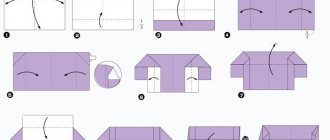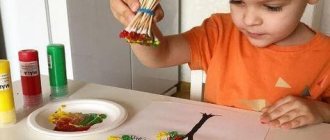Manual and artistic labor as a type of labor for preschool children
CONTENT
1. Introduction 2
2. Characteristics and importance of manual and artistic labor for the development of the personality of preschool children 3
3. Methodology for organizing and managing manual and artistic labor in different age groups 6
4. Conclusion 9
References 10
Labor is a purposeful human activity aimed at modifying and adapting natural objects to satisfy one’s needs.
K.D. attached great importance to labor education. Ushinsky - “Education should not only develop the mind, equip it with knowledge, but also ignite in a person a thirst for serious work...”
A.S. attached great importance to work. Makarenko, N.K. Krupskaya, V.A. Sukhomlinsky. Throughout the development of preschool education, much attention was paid to the problem of labor education of preschoolers:
- it was considered important and obligatory to introduce self-service work, work in the garden and in the garden, manual labor with various materials.
- the leading tasks were identified - to learn to work with joy; teach you to work efficiently.
Since 1964, systematic in-depth studies of the problem of labor education began: V.G. Nechaeva, G.N. Godina, D.V. Sergeeva, R.S. Bure, A.D. Shatova and others.
Their research answered the question about the content, means, methods and forms of labor organization and its role in educating the personality of a child of childhood.
The absence of a labor component in the educational process can lead to a delay in personal development.
Children's manual labor consists of independently making crafts using simple tools. This work, as a rule, has a practical, to a certain extent useful orientation. Children’s awareness of the expediency of their work activity has a significant impact on its quality, on the attitude of each child to the process and result of work. The individual nature of manual labor (meaning that even with collective work, each of the children performs some part of it with their own hands), provided that all children are consistently introduced to it, allows us to record and correct some shortcomings. Work becomes an effective means of education and personal development only when it is naturally included in the daily life of the kindergarten, is aimed at satisfying children’s interests, is feasible for the child,
Carrying out collective tasks develops in children the ability to negotiate with each other, subordinate their interests and desires to a common goal, fosters a sense of camaraderie, mutual assistance, responsibility, and develops initiative and ingenuity. In the process of performing collective tasks of a visual nature, children learn to independently plan the upcoming work, coordinate their actions with the general plan, think through the sequence of its implementation, select and use the necessary visual material. At the same time, in collective work, the individual characteristics of children are clearly revealed and creative abilities are formed.
Artistic labor is the work of a child with various materials in order to create useful and artistically and aesthetically significant objects and products to decorate his life, games, work and leisure. This child labor is a decorative, artistic and applied activity, since the child, when creating beautiful objects, takes into account the aesthetic qualities of materials based on his ideas, knowledge and practical experience acquired in the process of work. Properly organized manual and artistic work gives children knowledge about the quality and capabilities of materials, stimulates the desire to master the characteristics of craftsmanship, and introduces them to decorative and applied arts.
The formation of a child’s personality is impossible without labor education. In the senior and preparatory groups, the main role is played by manual labor with elements of creativity. The manifestation of creativity of preschoolers is determined by the nature of the implementation of the mental tasks offered to them. It is important that children can release their creative energy. In terms of practical significance, the basic skills acquired in handicraft classes are needed by every person. In these types of work, many important qualities are cultivated: the habit of effort, the ability to overcome obstacles, responsibility, the ability to plan work and anticipate the stages in the sequence of its implementation.
In particular, beadwork is a type of needlework that can be used to solve the following problems:
· instill interest in the culture of their homeland, in the origins of folk art, cultivate an aesthetic attitude to reality, hard work, accuracy, perseverance, patience, the ability to complete the work started, mutual assistance in carrying out work, an economical attitude to the materials used, instill the foundations of a work culture.
· develop motor skills, imaginative thinking, attention, imagination, creativity, and form aesthetic and artistic taste.
In the process of classes, children develop attention, observation, imagination, fantasy, and creativity. In every task, in every lesson, children are given the opportunity to imagine, and are encouraged to bring their own images into the work. Practical work on beadwork develops the eye and fine motor skills of the hands, which is an important element of general labor training.
In the process of engaging in artistic work, all mental processes are formed in children of senior preschool age, creative abilities and a positive emotional perception of the world around them develop. N.K. also attached great importance to classes in artistic manual labor in the comprehensive development of the individual, and especially in moral and aesthetic education. Krupskaya: “Classes in artistic manual labor should be gymnastics for the eyes and touch, establish the coordination of visual impressions and motor reactions, and provide a concrete acquaintance with the world of things.”
Learning through artistic and manual labor classes is impossible without the formation of such mental operations as analysis, comparison, and generalization. In the process of observation, when examining objects and their parts, the size and location of parts in an object, the color image of objects of different shapes, their comparison and establishment of differences. At the same time, children learn to compare objects and phenomena and highlight what is common and different in them, and combine objects by similarity.
In art classes, children's speech develops: mastering the names of shapes, colors and their shades, spatial designations that help enrich the vocabulary.
A child who can do a lot feels confident among his peers. It is also desirable in their games. In their little affairs. All this provides the child with a comfortable position among children and adults, and contributes to the manifestation and formation of such an important personal quality as independence. The child becomes more sensitive to the beauty in the surrounding life, in hand-made objects and people. The child begins to appreciate the results of the labor of not only his own, but also those of others.
Junior groups. It is necessary to arouse interest in “researching” the material and working with it, help to gain confidence in one’s own abilities, and enjoy the result of one’s work. It is necessary to encourage children to master spatial relationships between objects and certain physical laws, and to understand the properties of materials. To develop in children basic practical skills in working with materials and tools.
Middle group. There is already training in paper construction: bend a rectangular sheet of paper in half, aligning the sides and corners, and glue the parts to the main shape. You can teach how to make crafts from natural materials: bark, branches, leaves, cones, chestnuts, etc. The teacher teaches how to use glue and plasticine to secure parts; use reels, boxes of various sizes, plastic bottles, etc. in crafts.
Senior group. The ability to work with paper is improved: bend the sheet four times in different directions; work according to the finished pattern. Children learn to create three-dimensional shapes from paper: divide a square sheet into several equal parts, smooth out the folds, cut along the folds. Training continues in creating toys, souvenirs from natural materials (cones, branches, berries) and other materials (spools, colored wire, empty boxes), firmly connecting the parts. The ability to independently make toys for role-playing games is developed; souvenirs for parents and kindergarten staff; Christmas tree decorations. It is good to involve children in the production of manuals for classes and independent activities, repairing books, and printed board games.
Preparatory group for school. Here you can already divide the work of a teacher into several types:
Working with paper and cardboard - continue learning how to fold rectangular, square, round paper in different directions; use paper of different textures, make markings using a template; create fun toys; creating objects from strips of colored paper, selecting colors and their shades when making toys, souvenirs, costume parts and decorations for the holidays; developing the ability to use a sample; creating a variety of three-dimensional toys using the origami technique.
Working with fabric - learning how to thread a needle, tie a knot, sew on a button, a hanger, sew simple items with a needle-forward seam; teach how to make applique using pieces of fabric of various textures, apply an outline using chalk and cut out in accordance with the intended plot.
Working with natural materials - creating figures of people, animals, birds from acorns, pine cones, seeds, etc., conveying the expressiveness of the image, creating general compositions.
Conditions for independent creative activity of preschool children:
· a subject-development environment rich in iso-materials and a variety of materials for children’s artistic creativity;
· free access to materials and the opportunity to experiment with them;
· availability of samples of products and crafts;
· use of artistic products created by children to decorate a preschool institution, prepare attributes for performances, organize exhibitions, and participate in competitions;
· creation of a museum of children's crafts, albums, books;
· direct involvement of parents in the process of creative activity with children.
To successfully teach preschoolers manual and artistic work, it is necessary to carry out certain preliminary work:
· creation of exhibitions
· creation of collections (candy wrappers, buttons, shells, stones, etc.)
· creation of albums (samples and diagrams of crafts, types of fabrics, herbarium, etc.)
· experimentation
· viewing filmstrips
· reading literature
· looking at paintings
· excursions
· collages
Materials and tools necessary for manual and artistic labor in preschool educational institutions:
· natural material (spruce, pine, cedar cones, conifer needles, bark, leaves, fruit and berry seeds, eggshells, pebbles, cereals, vegetable and flower seeds)
· waste material (boxes and jars of different sizes, disks, lids, tubes, candy wrappers, etc.)
· paper (plain, corrugated paper, napkins, newspapers, cardboard, foil)
· fabric, wire, cotton wool, cellophane, beads, foam rubber, buttons, etc. d.
· scissors, glue, plasticine, brushes, sewing needles.
Manual and artistic labor - by its purpose, is labor aimed at satisfying the aesthetic needs of a person.
Its content includes the production of crafts from natural materials, paper, cardboard, fabric, wood. This work contributes to the development of imagination and creative abilities; develops small arm muscles, promotes endurance, perseverance, and the ability to finish what you start.
Children delight other people with the results of their work by creating gifts for them.
Artistic work in a preschool institution is presented in two directions: children make crafts and learn to decorate the group room for the holidays with their products, design exhibitions, etc.
Certain elements of manual and artistic labor can be introduced already in younger groups.
In this case, the participation of an adult is mandatory. More precisely, children help an adult in creating crafts. And although the activity of children of this age is minimal, involvement in such interesting work is very useful.
The child sees how, in the hands of the teacher, a simple stick suddenly turns into a doll, and a ball into the head of a funny clown. This “magic” fascinates children, delights them and motivates them to their own activities.
1. Bondarenko T. Introducing preschoolers to work. Methodical manual: - Method; 2014, 208 pp.
2. Bure R. Preschooler and work. Theory and methodology of labor education. A manual for teachers of preschool institutions: - Mosaic-Synthesis; 2011
3. Dmitriev Yu.A. Preparing students for labor education of preschool children // Teacher of the XXI century. No. 1, 2013, p. 104-109
4. Karpyuk G.A., Shabalin E.S. Educators on the organization of interaction with parents in the labor education of preschoolers // Preschooler. methodology and practice of education and training. No. 4, 2012, p. 54-56
5. Kutsakova L.V. Construction and manual labor in kindergarten. Program and methodological recommendations. For children 2-7 years old: - Sphere, 2011.
6. Saygusheva L. I. Technologies for introducing preschool children to work: Phoenix, 2013, 221 p.
7. Saygusheva L.I. Education of labor activity in children of senior preschool age: LAP LAMBERT, 2012, 219 p.
8. Semenova N. A. Possibilities for organizing research activities in the process of labor education of preschoolers // Kindergarten: theory and practice. No. 8, 2011, p. 70-75
9. Khlybova G.V. Labor education of preschool children (from work experience). Collection of proceedings of the conference “Education: traditions and innovations”. 2014, p. 450-452
We create and craft. Manual labor in kindergarten and at home. For classes with children 4-7 years old
That's how accordions are!
See what amazing toys you can make from accordion-folded paper. These crafts will decorate the New Year tree and the interior of the room. And everyone will be happy to receive such a souvenir as a gift!
Children love making such toys because they are easy to make. Children love to create their own crafts using this method and decorate them with their own cut out patterns. Teach the children to fold paper strips like an accordion (Fig. 7 a
) and make different cuts on them, such as in the proposed figure (Fig. 7
b
) or others.
Invite the children to unfold the strips, admire the openwork pattern, and then fold them in different ways, both into a fan and into a cylinder. These strips can be used to make lanterns. If you glue the parts in pairs, you get a pentagonal lantern. Or you can glue only the two outer parts - you get an original three-dimensional flashlight. The lanterns with pendants are very beautiful (Fig. 7 d
). You can make a garland by connecting several lanterns together.
Snow-white snowflakes are also good. Making them is not at all difficult. You need to assemble the accordion and pull it in the middle with a thread, and then fan it out and glue the top and bottom parts.
You can make a Japanese lantern. First, the accordion is folded (the folds are made narrow) and bent. Then the accordion is stretched, rolled into a cylinder and the outer folds are glued together. It is convenient to hang such toys on threads of Christmas tree rain (they are glued into the middle of the toy or a loop is made using a needle with a thread of Christmas tree rain threaded into it (the craft is stitched, the needle is removed and a loop is made)).
Wonderful butterflies are made from accordions. To do this, cut out two ovals (one large, the other smaller), fold them, join them together and tie them in the middle with a strong wrapper folded into a flagellum.
You can make an angel (Fig. 8). First, glue the paper cone together. Then they cut out a circle and fold it like an accordion (the fold lines extend from the center of the circle). The resulting part is smeared in the middle with glue and put on the cone. Then they make the wings, folding the pattern into small folds; tie it in the middle and use PVA glue to glue it to the angel’s back. Then they cut out the head, draw facial features with a felt-tip pen and glue it to the top of the cylinder.
A beautiful New Year's souvenir can be made from an accordion, which serves as a base or stand for the composition. Invite the children to fold accordions from white construction paper and place them on the table, and then cut out any shapes and glue them closer and further to the folds, creating perspective. The plot can be anything. If you make holes on the upper parts of the folds, then the figures can not be glued, but inserted into these holes. The result is a miniature tabletop theater.





